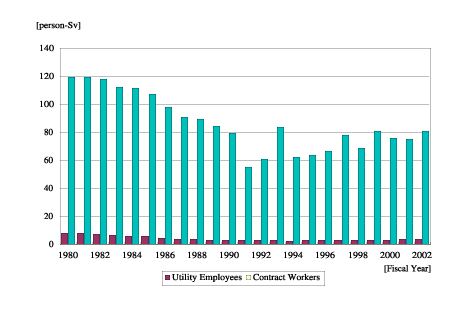|
Data: Nuclear Workers' Radiation Exposure and TEPCO Coverup Accident
Figure 1: Annual Collective Dose of Workers' Radiation Exposure at Nuclear Plants, 1980-2002 (FY)

The workers' exposure to radiation at nuclear power stations reached its maximum around 1980, but declined there after as a result of the growing public criticism. Within the strengthened anti-nuclear power movement the publishing of photograph collections and books, which unveiled the truth about the exposed workers, culminated in 1979. And in 1981, subcontractors working at power plants formed their own union. As a result of these activities, measures to reduce the radiation dose were implemented. For example, automated machines were increasingly introduced in a highly radioactive work environments.
However, since the beginning of the 1990s a tendency towards an increase in radiation exposure can be seen once again. There are two reasons for this development. The focus has been shifting away from measures to decrease the dose level towards improving economic efficiency of reactor operation as some of nuclear power stations became old. The many prominent increases in the 1990s are a result of the exchange of large, timeworn equipment (i.e. the year of 1993). It is predictable that the radiation dose from now on will further increase.
However, the surge in 2002 can be attributed to increase a number of inspections after the disclosure of the troubles at the TEPCO's plants. At all 53 nuclear power units the total increase in radiation dose since last year has been 6 person-Sv. But if one looks only at BWRs, the increase was 12 person-Sv, or 25% up from the previous year. If the radiation at PWRs had not decreased by 6 person-Sv, this would have been the highest value in 14 years.
The increase has been especially large at Onagawa, Fukushima No. 1 and No. 2 Kashiwazaki Kariwa and Hamaoka. At these five nuclear power plants the increase has been 14 person-Sv. At Onagawa and Kashiwazaki Kariwa, the radiation dose has been the highest since the operation has been started. The Figure 2 compared the dose level with that of an average for the past three years. The averaged value was used because the exposure dose occasionally declined considerably last year.
There were five power plants at which workers were exposed to more than 15mSv. At Onagawa and Hamaoka the maximum was 19.7 mSv, at Fukushima No. 1 19.6 mSv, at Fukushima No. 2 18.9 mSv and at Kashiwazaki Kariwa 18.4 mSv. In all cases, most of the exposed workers were subcontractors.
However, the data from the Agency for Nuclear and Industrial Safety (ANIS) does not list any values for workers working at multiple nuclear power stations, since the data is only released for each nuclear power plant.
However, the ANIS only releases radiation dose data compiled by each power plant. They reported that those who exposed more than 15 mSv were 5 utility employees and 556 contract workers. Yet, if we look at the workers' exposure data, by the Radiation Dose Registration Center for Workers (Hosha-sen Jyuji-sha Chuo Touroku Center), there were actually 958 workers, which included three workers whose radiation exposure exceeded 20mSv.
Table 1: Annual Collective Dose of Nuclear Workers(person-Sv)

Figure 2: Workers' Radiation Dose at the "Troubled" Nuclear Power Plants

Return to NIT 96 Contents
|

